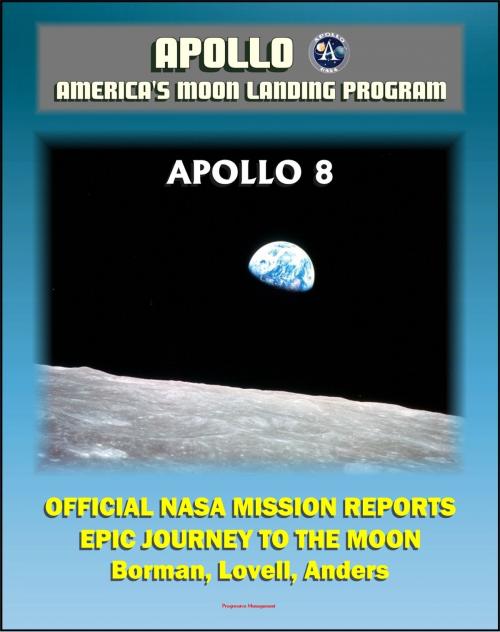Apollo and America's Moon Landing Program: Apollo 8 Official NASA Mission Reports and Press Kit - The Epic 1968 First Flight to the Moon by Borman, Lovell and Anders
Nonfiction, Science & Nature, Science, Physics, Astronomy, History, Americas| Author: | Progressive Management | ISBN: | 9781466078482 |
| Publisher: | Progressive Management | Publication: | November 10, 2011 |
| Imprint: | Smashwords Edition | Language: | English |
| Author: | Progressive Management |
| ISBN: | 9781466078482 |
| Publisher: | Progressive Management |
| Publication: | November 10, 2011 |
| Imprint: | Smashwords Edition |
| Language: | English |
Three comprehensive official NASA documents - converted for accurate flowing-text e-book format reproduction - chronicle the epic December 1968 mission of Apollo 8, the first manned lunar orbit mission by Frank Borman, James Lovell, and Bill Anders.
Two technical mission reports, the Manned Spacecraft Center (MSC) Apollo 8 Mission Report and the NASA Headquarters Mission Operation Report (MOR), provide complete details about every aspect of the mission.
Apollo 8 MSC Mission Report: Mission description, pilots' report, lunar decent and ascent, communications, trajectory, command and service module performance, mission support performance, assessment of mission objectives, launch vehicle summary, anomaly summary (CSM, government furnished equipment), conclusions, vehicle descriptions. Apollo 8 MOR: Mission design and execution, spacecraft performance, flight anomalies, detailed objectives and experiments, launch countdown, detailed flight mission description, back contamination program, contingency operations, configuration differences, mission support, recovery support plan, flight crew, mission management responsibility, program management, abbreviations and acronyms. Apollo 8 Press Kit: Detailed preview from countdown to landing.
The mission objectives for Apollo 8 included a coordinated performance of the crew, the command and service module, or CSM, and the support facilities. The mission also was to demonstrate translunar injection; CSM navigation, communications and midcourse corrections; consumable assessment; and passive thermal control. The detailed test objectives were to refine the systems and procedures relating to future lunar operations.
All primary mission objectives and detailed test objectives were achieved. All launch vehicle and spacecraft systems performed according to plan. Engineering accomplishments included use of the ground network with onboard navigational techniques to sharpen the accuracy of lunar orbit determination and the successful use of Apollo high-gain antenna -- a four-dish unified S-band antenna that deployed from the service module, or SM, after separation from the third stage.
Mission Highlights
Apollo 8 launched from Cape Kennedy on Dec. 21, 1968, placing astronauts Frank Borman, James Lovell Jr. and William Anders into a 114 by 118 mile parking orbit at 32.6 degrees.
During the second revolution, at two hours, 50 minutes ground elapsed time, the S-IVB third stage restarted for a five-minute, 17-second burn, initiating translunar coast. Following S-IVB/CSM separation at three hours, 21 minutes, a 1.5 feet per second radial burn of the SM reaction control engines was initiated to establish sufficient distance for S-IVB propellant dumping. Following the propellant dumping, which sent the stage into diverging trajectory and solar orbit, the separation distance still was deemed inadequate and a second SM reaction control burn of 7.7 feet per second was performed.
The first midcourse correction occured at about 10 hours, 55 minutes into the mission and provided a first check on the service propulsion system, or SPS, engine prior to committing spacecraft to lunar orbit insertion. The second and final midcourse correction prior to lunar orbit insertion occurred at 61 hours, 8 minutes, 54 seconds.
Loss of signal occurred at 68 hours, 58 minutes, 45 seconds when Apollo 8 passed behind the moon. At that moment, NASA's three astronauts became the first humans to see the moon's far side. The first lunar orbit insertion burn, at 69 hours, 8 minutes, 52 seconds, lasted four minutes, two seconds and reduced the spacecraft's 8,400 feet per second velocity by 2,994 feet per second, resulting in an initial lunar orbit of 70 by 193 miles.
Three comprehensive official NASA documents - converted for accurate flowing-text e-book format reproduction - chronicle the epic December 1968 mission of Apollo 8, the first manned lunar orbit mission by Frank Borman, James Lovell, and Bill Anders.
Two technical mission reports, the Manned Spacecraft Center (MSC) Apollo 8 Mission Report and the NASA Headquarters Mission Operation Report (MOR), provide complete details about every aspect of the mission.
Apollo 8 MSC Mission Report: Mission description, pilots' report, lunar decent and ascent, communications, trajectory, command and service module performance, mission support performance, assessment of mission objectives, launch vehicle summary, anomaly summary (CSM, government furnished equipment), conclusions, vehicle descriptions. Apollo 8 MOR: Mission design and execution, spacecraft performance, flight anomalies, detailed objectives and experiments, launch countdown, detailed flight mission description, back contamination program, contingency operations, configuration differences, mission support, recovery support plan, flight crew, mission management responsibility, program management, abbreviations and acronyms. Apollo 8 Press Kit: Detailed preview from countdown to landing.
The mission objectives for Apollo 8 included a coordinated performance of the crew, the command and service module, or CSM, and the support facilities. The mission also was to demonstrate translunar injection; CSM navigation, communications and midcourse corrections; consumable assessment; and passive thermal control. The detailed test objectives were to refine the systems and procedures relating to future lunar operations.
All primary mission objectives and detailed test objectives were achieved. All launch vehicle and spacecraft systems performed according to plan. Engineering accomplishments included use of the ground network with onboard navigational techniques to sharpen the accuracy of lunar orbit determination and the successful use of Apollo high-gain antenna -- a four-dish unified S-band antenna that deployed from the service module, or SM, after separation from the third stage.
Mission Highlights
Apollo 8 launched from Cape Kennedy on Dec. 21, 1968, placing astronauts Frank Borman, James Lovell Jr. and William Anders into a 114 by 118 mile parking orbit at 32.6 degrees.
During the second revolution, at two hours, 50 minutes ground elapsed time, the S-IVB third stage restarted for a five-minute, 17-second burn, initiating translunar coast. Following S-IVB/CSM separation at three hours, 21 minutes, a 1.5 feet per second radial burn of the SM reaction control engines was initiated to establish sufficient distance for S-IVB propellant dumping. Following the propellant dumping, which sent the stage into diverging trajectory and solar orbit, the separation distance still was deemed inadequate and a second SM reaction control burn of 7.7 feet per second was performed.
The first midcourse correction occured at about 10 hours, 55 minutes into the mission and provided a first check on the service propulsion system, or SPS, engine prior to committing spacecraft to lunar orbit insertion. The second and final midcourse correction prior to lunar orbit insertion occurred at 61 hours, 8 minutes, 54 seconds.
Loss of signal occurred at 68 hours, 58 minutes, 45 seconds when Apollo 8 passed behind the moon. At that moment, NASA's three astronauts became the first humans to see the moon's far side. The first lunar orbit insertion burn, at 69 hours, 8 minutes, 52 seconds, lasted four minutes, two seconds and reduced the spacecraft's 8,400 feet per second velocity by 2,994 feet per second, resulting in an initial lunar orbit of 70 by 193 miles.















